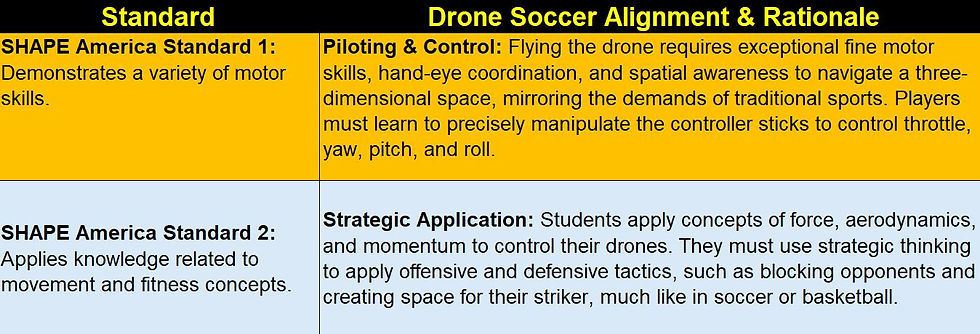An Interdisciplinary Program

Safety and Compliance
-
Safety & compliance documentation (downloadable)
-
The default regulation for drones weighing under 55.0 pounds is Part 107. Almost all non-recreational drone flying is regulated by FAA Part 107.
-
FAA Part 107 regulations do not apply to indoor drone flights because they occur outside the National Airspace System (NAS). While the FAA doesn't regulate indoor flights, the property owner or building manager has the final say and can set their own rules. However, if the drone exits an indoor space to fly in the NAS, then Part 107 regulations would apply
-
A 10x20x10 netted-enclosure allows safe drone flights indoors
-
Personal Protective Equipment (PPE)
-
To ensure the safety of all participants, the following Personal Protective Equipment is mandatory during all drone building, repair, and flight activities:
-
Goggles
-
Purpose: To protect the eyes from flying debris, such as propeller fragments or small parts that may come loose during a crash.
-
Requirement: All individuals inside the netted arena, including pilots, referees, and coaches, must wear safety goggles or glasses that meet industry standards.
-
-
-
Fire Retardant Gloves
-
Purpose: To protect hands from potential burns that can occur from soldering or from a shorted-out battery.
-
Requirement: Individuals performing soldering or electrical work on the drones must wear fire-retardant gloves.
-
-
-
-
-
Safety & compliance documentation (downloadable)
-
Proof of insurance (COI).
-
Background checks on all employees and volunteers.
-


Drone Soccer Safety First
Drone Soccer Code of Conduct
All participants in the drone soccer program are expected to uphold the highest standards of sportsmanship, safety, and respect. Adherence to this code is mandatory for all team members, coaches, and volunteers.
-
Safety First: Prioritize the safety of all individuals and equipment. Always follow established safety procedures and rules. Never fly a drone in an unsafe or reckless manner.
-
Respectful Conduct: Treat all teammates, opponents, coaches, and referees with respect and dignity. Do not engage in any form of bullying, harassment, or unsportsmanlike behavior. This includes both physical and verbal actions.
-
Teamwork and Collaboration: Drone soccer is a team sport. Work together to build, repair, and strategize. Support your teammates and contribute to a positive and inclusive team environment.
-
Honesty and Integrity: Compete with integrity. Report any rule violations, equipment issues, or safety concerns truthfully and promptly.
-
Care for Equipment: Treat all drones and team equipment with care. Drones are fragile and expensive, and proper handling ensures everyone can continue to participate.
-
Learning and Growth: Embrace the educational aspects of the program. Be open to learning from mistakes, both on and off the field. Use failures as opportunities for growth and problem-solving.
-
Digital Citizenship: Maintain positive and respectful interactions online and in all digital communications related to the program. Be mindful that your actions reflect on the entire team.
Pre-Flight Checklist
Before every flight, whether for practice or a match, each pilot is responsible for conducting a thorough pre-flight check to ensure the drone is safe and ready to fly.
-
Pilot and Team Check:
-
Confirm all team members are present and aware of the flight plan.
-
Verify all pilot goggles are clean and functioning properly.
-
Ensure all necessary tools and spare parts are readily available.
-
-
Drone Visual Inspection:
-
Inspect the drone cage for any cracks or damage.
-
Check that all propellers are securely attached and free from nicks or deformities.
-
Confirm all motors are spinning freely and are not obstructed.
-
Verify the flight controller, battery, and radio receiver are securely mounted.
-
Check for any loose wires or connections.
-
-
Radio and Power Check:
-
Power on the radio transmitter.
-
Check the transmitter's battery level.
-
Ensure the transmitter is bound to the correct drone.
-
Connect the drone battery, listening for the proper startup tones from the motors.
-
-
Arming and Control Check:
-
Safely place the drone on the ground in the designated launch area.
-
Without propellers, gently arm the drone.
-
Check all control inputs (throttle, yaw, pitch, roll) to ensure the motors respond correctly.
-
Disarm the drone and power down after the check is complete.
-






